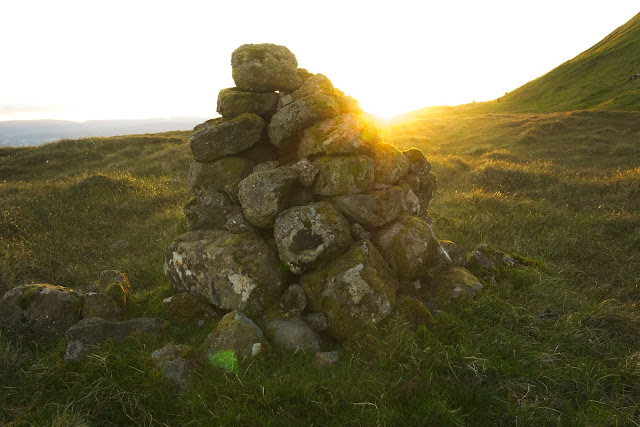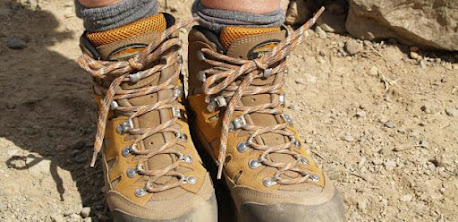I love sea cliffs. The remote, elusive Faroe Islands have some of the highest of Europe, so it had been on my list of travel destinations for some years. June 2019 I did it. I went on a 10 day hiking and photography trip, camping along the way, hopping on and off buses and ferries from island to island. And had so much fun.
I had physically and mentally prepared myself for days of pouring rain, mountain tops hidden from view by mist. Being blown around by storms. A wild sea that battered the high, rugged cliffs. Instead I got 10 mostly sunny, windstill days. I often found myself hiking alone in beautiful scenery, sometimes even in the light of the midnight sun. A different experience altogether, but a wonderful one. Who knew that these 18 small islands with their stunning coastline in the middle of the Atlantic ocean could be so peaceful?
 |
| Walking in the wonderful midnight sun. It's like a sunset that lasts for hours. |
The hikes I did (with descriptions)
- In two days: from Midvágur to Fjallavatn to Gásadalur. The part towards Fjallavatn has no visible trail or marking so you'll need to navigate it yourself, but is otherwise quite simple. The crossing from the cliffs at the end of Fjallavatn to Gásadalur is anything but simple: it also has neither trail nor marking and starts by ascending an impassible-looking slope above a cliff, then after the crossing of a valley climbs up an incredible steep slope before you reach the pass, and then you still have to navigate ridges with loose rock. Once you've made it down to the valley however, the final descend towards Gásadalur is easy again.
 |
| Hiking in the bare, grassy hills of Streymoy. |
- Crossing from Vestmanna to Streymnes/Hvalvík, about half a day. This route has no visible trail or marking save from the occasional cairn. It goes into the empy inland hills and offers therefore a different experience than the coastwalks do. I wasn't lucky with the weather that morning, but on a clear day I'm sure the views will be good.
- From the village of Mykines to the Mykines Hólmur lighthouse. A beautiful, short and easy hike on a good trail that offers amazing views. If you go here during the summer months, you'll see breeding colonies of sea birds like gunnets and puffins, so great bird spotting opportunities as well. For the best experience, stay at night in the Mykines village and set off well before the ferry with day tourists arrives.
- From the camping of Midvágur to Leitisvatn/Sorvagsvatn/Traenipan (yes the number of names is confusing. The lake has two names, both Leitisvatn and Sorvagsvatn, and Traenipan refers to viewpoint above the cliffs beyond the end of the lake from where you'll have a gorgeous view back over the 'floating lake'.) From the camping, it's a less than two hours walk. Once you're at the parking lot, the route continues on an easy, clear trail.
- From Trollanes to the Kallur lighthouse, a few hours total. I advise to only walk this trail when it's been dry for at least two days, because it is very, very muddy, and in a lot of places a slip could mean a deadly fall down the steep, slippery grass slopes it traverses. I managed to keep from slipping but my heart was in my throat a few times. Unfortunately on this hike a thick sea mist engulfed me and wouldn't lift, and so I didn't get to see the huge cliff behind the lighthouse. I'm sure the view will be stunning. I heard the birds and could smell the sea, but saw only white. ;)
- To the top of the Klakkur mountain from Klaksvik, a few hours total. This trail is very muddy but being worked on. A slip here however will leave you just muddy, not dead. The view from the top over the fjords and the northeastern islands is outstanding.
- From the village of Nolsoy to the lighthouse at the other side of the island, half a day total. No epic views or walking alongside cliffs here, but a nice, quite easy walk on a recently marked route that in part hasn't a visible trail yet. I hiked it at night, in the midnight sun and that was a peaceful experience.
- On the island Suduroy: from Sandvik to the sea stack Ásmandastakkur to the village Hvalba, half a day. Once you step off the road, there's no visible trail or marking, however the way to Ásmandastakkur is simple. The crossing from there to Hvalba has some steep parts, but is mostly not that hard. You'll have to climb over several fences to reach the village though, so that is a bit annoying.
My favorite photographs
 |
The lighthouse of Mykines. I went straight from the airport to the Mykines ferry - great way to start a trip. I used an ultrawide lens for this photo, to cature that feeling of wide open space.
|
 |
| Spotting and photographing puffins on Mykines. It was the first time I've seen these sea birds. They're much smaller than I thought they would be, and altogether very cute. |
 |
| Tiny puffin, steep cliff. I liked these shots where you can also see their living environment more than my close ups. |
 |
| A long exposure of the massive Ásmundarstakkur. I went for a vertical orientation and longer focal length, to better show the scale of this huge sea stack. |
 |
Walking further along the impressive west coast of Suduroy, the most southern island. The ocean didn't behave like an ocean at all, it was so, so calm. I found an interesting foreground in this gorge.
|
 |
| Sorvágsvatn at one o'clock at night. This is the famous lake that thanks to an optic illusion appears to be floating on top of the cliffs. It's a much photographed composition, but none the less a beautiful location very well worth seeing for yourself. I hiked this trail late at night and saw only a few people along the way, and then was rewarded by the stunning view of the 'floating lake' with the glow of the midnight sun behind it. I was lucky there was no wind, because to get this view you need to crawl quite close to the edge of the cliff - please be careful! You'll need an ultrawide lens to be able to fit it all in. Or take a panorama. |
 |
| The sheer height of the cliffs at Vestmanna will blow you mind. This photo is taken from the boat of the Vestmanna birdcliffs tour. The weather wasn't so grim, but I decided a moody black and white edit would fit the scene. |
 |
| Exploring the beautiful islands and fjords of the northeast. |
 |
Exploring the north coast of the Vágar. This might be my favorite place in all of the Faroe islands. Waterfalls, gorges, a black sand beach, epic sea clifs - what's not to like here?
|
 |
So many different compositions in this location!
|
 |
Some truly epic light.
|
 |
Wild camping on the edge of sea cliffs. My most beautiful wild camping spot yet?
|
 |
One last composition in this place. My last full day on the Faroe islands, and behold, finally some proper waves! Unfortunately, to get to Gasadalur I had to climb straight into the fog.
|
 |
| The waterfall of Gasadalur, another beautiful sight and famous photo composition. I reached it after a very hard hike in thick sea mist however, so I think this picture is still well earned :) |
Want to travel to the Faroe Islands? Some tips
- Buy a
travel card. It gives you 7 days of unlimited access to the buses and ferries (except the private-run one to Mykines) for about 90 euro, so it's affordable, convenient and a great way to support local public transport. It's easy to fill in the gaps with an occasional hitchhike. Good to know: the boat to Mykines fills up quickly, so it's best to book it as soon as you've booked your flight.
- Check shortly before you leave for your journey on the website of
Visit Faroe Islands for which hikes you must pay a fee. A quick google search will learn that a lot of people have Opinions about the existence of these fees, and I definitly agree. Rapidly increased numbers of visitors to a few famous locations is an issue but charging
hikers, who have by nature the least environmental impact, high fees is just not the right way forward. Putting proper hiking infrastructure in place and perhaps a restriction in numbers is. Sadly all land on the Faroes is in private hands, so owners can charge what they like. (Faroese goverment, please change that? These stunning nature areas shouldn't be private property)
- Be prepared for
any weather. Take good waterproofs, warm clothing, a hat and gloves, but also do not forget t-shirt and shorts, sunglasses and sun lotion. Interestingly, temperatures barely dropped during the nights. I often woke up slightly sweaty in my 0°C down sleeping bag.
 |
| The campsite of Mykines. |
- You will save
so much money if you chose to go camping. Just take a good quality tent that can handle rain and hard wind, and you'll be fine (just take your tent down and seek shelter if a real storm hits). Wild camping isn't allowed, but if you're alone in a remote location most likely no one will bother you. I did one night of wild camping and also pitched my tent two times on a random field near a public toilet - I asked a few locals, and they were fine with it. The rest of the time I stayed at
official campgrounds, which the Faroe Islands has quite a lot of. Beware, the campground in Klaksvik is still listed but does not exist anymore! Some campgrounds have very nice facilities, others are merely a field with a public toilet nearby. I can especially recommend the campground in Vestmanna. It has a beautiful service building where you can also lounge and cook, and is run by an incredibly kind woman. The campsite at Tórshavn and the Midvágur hostel have good facilities as well. The Mykines campsite also deserves a mention because of the stunning location.
- The Bradt travel guide will problably be useful, but I didn't buy it. I did buy the F&B 1:100.000 map, and I used it in combination with a downloaded map on my phone. As I already mentioned, be aware that hiking routes marked on the map may to not be actual visible, marked trails. Navigating the rougher off-trail routes is only recommended for experienced hikers. Unsure? You can always hire a local guide. Despite the Faroe islands being more on the radar lately, tourism in general and especially hiking tourism is still very much in a beginning state at the moment. They are still flailing about a bit and the locals themselves seem rather bemused about why tourists would want to come to their islands. So, do not expect hiking facilities like for example those in the Alps. That said, for adventurous nature lovers the Faroe Islands are a wonderful playground.




















Comments
Post a Comment